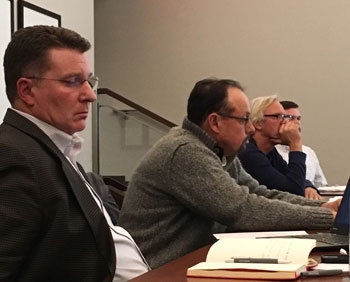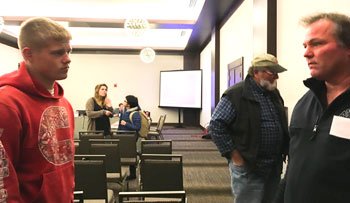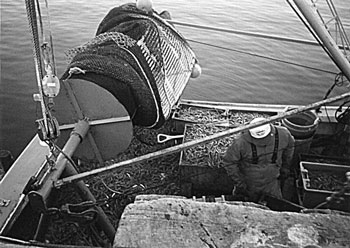To Shrimp Or Not To Shrimp
by Paul Molyneaux

Hoping to salvage some kind of season, Maine DMR Commissioner Pat Keliher, left, made a motion for a quota equal to what was caught in 2017—32.6 tons—but that was not enough. “Our department has limited resources,” he said. “We can’t justify putting them into the RSA. We will conduct biological sampling, and that’s all.”
To shrimp or not to shrimp? That was the big question on the table at the Atlantic States Marine Fisheries Commission (ASMFC) northern shrimp section meeting in Portland, Maine on November 29. The ASMFC manages New England’s northern shrimp fishery, and this iconic species, Pandalus borealis, may be, according to the science, on the verge of commercial extinction in the Gulf of Maine. Maine fishermen argued for a season, but after a day of heated and contentious meetings, the three commissioners representing Maine, New Hampshire and Massachusetts on the ASMFC’s northern shrimp section, voted not to “roll the dice” on this compromised stock. For the fifth straight year, there will be no shrimp season in Maine.
The Advisory Panel
The meetings started at 9:00 at the Westin Hotel. The industry advisory panel, the AP, chaired by boat owner and fisherman Gary Libby, and comprised of fishermen and processors from Maine, New Hamphire and Massachusetts, listened to a presentation by the Northern Shrimp Technical Committee (TC), which compiles the science for the resource, on the state of the Gulf of Maine shrimp stocks. ASMFC scientist Robert Eckert’s presentation showed graphs bottoming out, with shrimp biomass at a historic low. The scientists primarily blamed climate change for the terrible numbers. (http://www.asmfc.org/uploads/file/5a1deb972017NorthernShrimpAssessment_Final.pdf)
“We saw declines in the 1950’s and late 1970’s, which were associated with a warming trends,” said Maine biologist and TC member, Maggie Hunter. “Some of that might have had something to do with overfishing as well, especially in the 1970’s.”
The TC recommended continuing the moratorium that has been in effect since an aborted 2013 season, with the exception of a 13.3 metric ton (MT) research set aside (RSA)
But the fishermen and processors on the AP didn’t buy it.
“This is based on 15 hours of towing,” said Spencer Fuller, a long time shrimp processor in Maine. “I say open it up and let the economics decide.” Fuller has had a long history in the shrimp business and his argument that a reduced season will damage the processing infrastructure, and markets, hasn’t changed much in 20 years.
“It’s like ‘Groundhog Day,’” he said, referring to the movie in which the same scenario plays out over and over again.
Marshall Alexander, a Maine boat owner, offered his own critique of the assessment. “This is a pile of shit,” he said. “It’s just numbers.”
Spurred by Fuller, the AP voted to ask for a 2,000 MT quota, a significant jump from last year’s 50 MT quota, and the 13.3 MT quota recommended by the technical committee for 2018.
“The graphs are only as good as the data that goes into them,” said Gary Libby. Maybe the scientists are right, but we want a chance to find out. If the shrimp aren’t there, then we won’t fish them,” said Gary Libby.
The AP felt that in asking for 2,000 MT they might get at least something, but later that afternoon, at the ASMFC’s northern shrimp section meeting, New Hampshire and Massachusetts representatives killed any hope of an expanded season.
The Section Meeting

Eastern Maine Skippers Student, Zach Smith, left, from Narraguagus High School in Harrington, made the trip to Portland to learn how the shrimp fishery is managed. While Zach took notes on the AP meeting, he said there was so much contention in the room during the section meeting he was on the edge of his seat the whole time just waiting to see what would happen next. Pictured here, Zach talking to shrimp trappers, John Seiders and Craig Sprout about how his Skippers class can conduct an experimental trap fishery for shrimp. “We want to see what it will take to bring this resource back and have a shrimp fishery Downeast,” said Zach.
At the section meeting, held in one of the hotel’s large windowless banquet rooms, seats filled up and fishermen from all three states crowded the back of the room. Robert Eckert repeated his presentation for the section and standing room only crowd. The number offered only one bright spot, a set of graphs indicating a relatively good year class in 2015, which could recruit to the fishery as second year females in 2019.
Conveying the AP’s earlier decision, Gary Libby proposed a 2018 season. “We’d like a 2000 metric ton fishery,” he announced on the heels of Eckert’s report. The representatives from Massachusetts and New Hampshire asked him to repeat what he had said.
Mike Armstrong, the Massachusetts commissioner, was visibly shaking when he said he would vote against anything except the technical committee’s recommendation of 13.3 tons for 2018.
Ritchie White of New Hampshire explained his stance. “You know I’ve advocated for a fishery,” White said. “And I’d like to see it, but I’d like to give this 2015 year class a chance, and wait and look at it next year.”
“These guys only look at the numbers on paper,” Libby said afterward. “They don’t know what it’s like to have a boat.”
Northern shrimp have a curious life cycle that plays a key role in management. They spend their first two or three years as males, and then transform into females. In 2018, the 2015 year class would be mostly transitioning males and small females. What White argued for was letting that year class mature into larger females. Female northern shrimp carry their eggs, like lobsters, but unlike lobster fishing, which prohibits the taking of egg bearing females, the Maine shrimp fishery has traditionally targeted egg bearing females. In the past, the season has begun as early as December, and fishermen have caught shrimp moving inshore to release their eggs. Trays full of bright orange shrimp with turquoise colored eggs once supplied processors and roadside vendors in the early part of the season—until the shrimp started to drop their eggs in mid-February.
To give more protection those egg bearing females, Steve Train, a Maine fisherman, proposed a 500 MT season beginning on February 21, when most of the shrimp had shed their eggs. Pat Keliher, the commissioner of Maine’s Department of Marine Resources (DMR) and Maine’s representative to the ASMFC northern shrimp section—Maine’s only vote at the table—put the suggestion into a motion but could not get a second.
The Maine delegation made the case that the science was questionable and that in looking at some data on the large amounts of shrimp found in the stomachs of dogfish in the Gulf of Maine, there might be a lot of shrimp out there. Keliher also argued that the fishery might never come back and that a harvest should be allowed while there were any shrimp at all.
“We’re ready to roll the dice,” said Keliher, re-iterating Libby’s contention that if there were no shrimp the boats would not go.
“I’m not ready to roll the dice,” said White. New Hampshire’s commissioner, Doug Grout, and Massachusetts commissioner Armstrong agreed.
Hoping to salvage some kind of season, Keliher made a motion for a quota equal to what fishermen landed in 2017—32.6 MT out of the 50 MT quota—he even rounded the figure down to 32 tons, but that was not enough. Grout and Armstrong were implacable and immovable from their common agreement on the 13.3 ton RSA quota recommended by the technical committee. Among three voting members, they made the motion, seconded it and voted it through while Keliher and the Maine delegation fumed.
“They’re saving them for the dogfish,” said Gary Libby.
The Future of Maine’s Shrimp Fishery
Immediately after the vote, Keliher announced that Maine would not participate in the RSA fishery. “Our department has limited resources,” he said. “We can’t justify putting them into the RSA. We will conduct biological sampling, and that’s all.”
Keliher’s move stunned section chair, Dennis Abbot of New Hampshire, who said he hoped Keliher would reconsider. The meeting ended soon after the vote and Keliher defended his position on WABI news, saying that 13.3 MT was too small an amount to justify the expense of regulating the fishery.
According to a DMR spokesperson, Keliher would not support a fishery that did not give all shrimp license holders a chance to fish. Instead the DMR has initiated a research program and is seeking a trawler to collect samples. http://www.maine.gov/dmr/science-research/species/shrimp/winter2018.html

Re-rigged for the shrimp fishery 1999. There will be no shrimp season in Maine in 2017. In 2010 12.3 million pounds were landed, worth $6.7 million. Fishermen’s Voice photo
Many of the members of the AP, the Section, and the TC wonder if anything can be done to save the Gulf of Maine shrimp stocks. In addition to climate change and fishing pressure, scientists also note that shrimp face issues of predation by dogfish and cod, ocean acidification that can weaken their shells, and many other challenges posed by a rapidly changing ecosystem.
During the AP meeting, Craig Sproul, president of the Maine Shrimp Trappers Association, made a case for a trap only fishery, but the meeting was out of time and the panel did not discuss his proposal.
At present, Maine gets eighty percent of any quota decided on by the Section, and that quota is split between trawlers and trappers. Maine’s trawler fleet takes eighty-seven percent of Maine’s quota; trappers get thirteen percent. Sproul argued that given the current state of the resource, trapping may be the best gear to use to harvest whatever shrimp are available.
Some TC scientists agree, calling traps a “green” gear type that would only harvest large females and only if they were sufficiently abundant.
DMR commissioner Keliher moved, during the meeting, that his department be allowed to re-examine the eighty-seven/thirteen split between trawlers and trappers and that motion was seconded and approved. “Finally, I get a second,” he said.
At present, the TC has proposed a split of the 13.3 MT RSA between Massachusetts and New Hampshire. But based on past year’s landings, scientists doubt fishermen will harvest the entire quota.
“If it’s as bad as they say,” said Libby, “why have any season at all?”
